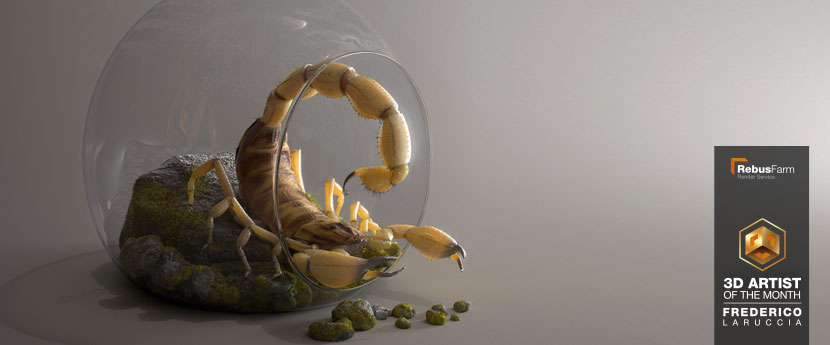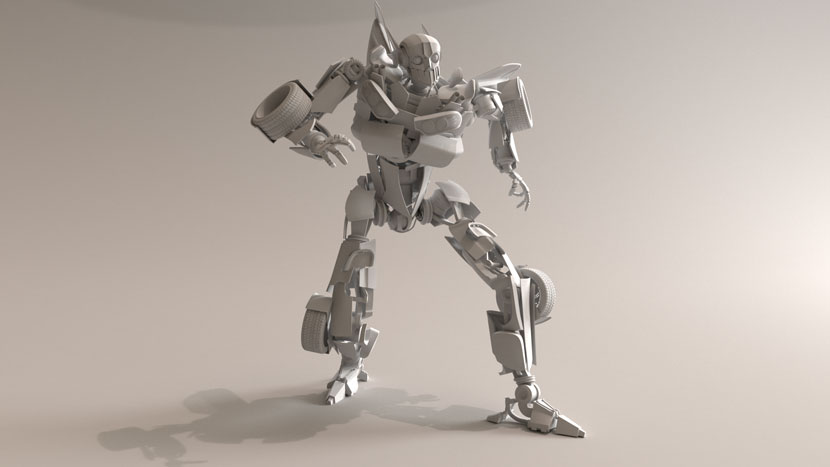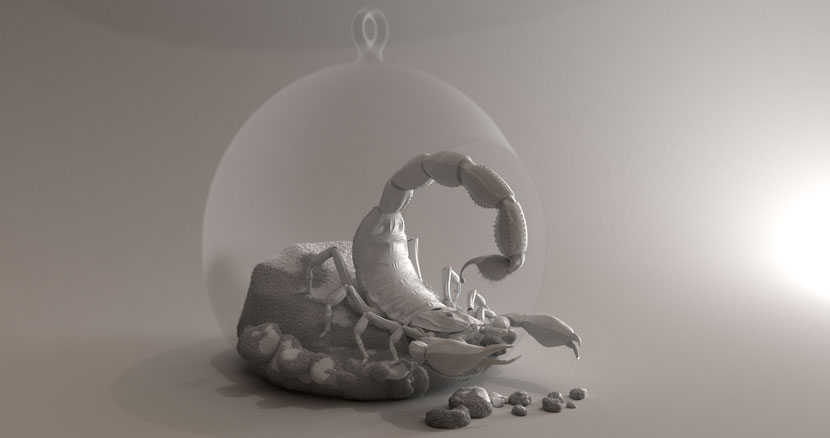Monday, July 2nd, 2018 by Julian Karsunky

Congratulations to Frederico Laruccia, our July 2018 3D Artist of the Month! Hailing from São Paulo, Brazil, the 3D generalist learned his craft on the other side of the world. In Malaysia, his initiative and talent as a student earned him an award for academic excellence. Frederico’s desire to further specialize in lighting and rendering lead to the creation of the scorpion pictured above, the initial entry in his ongoing ‘Mini World Series’.
In our feature interview, Frederico talks about the development process of his submission, ways to combat the sometimes lonely life as a freelancer and recounts a decisive meeting with a famous director.
 ‘Mini World Series – Scorpion’, wireframe.
‘Mini World Series – Scorpion’, wireframe.
Hi Frederico, thank you for taking the time! To start things off, please introduce yourself to our readers!
Hi everybody, my name is Frederico ‘Fred’ Laruccia, I am a 32 years old 3D generalist from São Paulo, Brazil, currently working exclusively freelance.
Do you recall when and how you first came into contact with CGI?
Yes, I still vividly remember! It was back in 2004 and I was attending a family reunion at my uncle Marcello’s house, who was already working in the industry. We were about to go home when my uncle called me over and showed me a WIP he was doing on his computer. This was the very first time I saw Maya. It was love at first sight.
How did this love then blossom into the desire to pursuit a professional career as a 3D artist?
After that fateful day, I was able to get my hands on a demo of Maya and just started messing around. As a Star Wars fan, I modeled one of my favorite ships from the series, the Naboo Star Fighter. From that day on, I knew what I wanted to do for the rest of my life.
What training or education do you have?
Fresh out of school in 2006, I completed several intensive courses in 2D and 3D animation at the ‘Academia de Animação e Artes Digitais’, or AAAD for short. The following year I interned at Laruccia Animation Studio, my uncle’s company, and enrolled in a bachelor’s program in Cinema Studies at FAAP, the Fundação Armando Alvares Penteado, one of Brazil’s most respected academic institutions. It only took me six months to realize I had chosen poorly, so I dropped out and just worked for the next couple of months.
Eventually my father, who was living in Malaysia at the time, presented me with the opportunity to come over and study Animation there. Gladly, I accepted and in 2008 I found myself on the other side of the globe, finally studying a subject that I was sure and passionate about.
Before being awarded the Chancellors Award for Academic Excellence, you made quite some waves during your time as a student, is that right?
Yeah, before even applying for the program, I had ensured that the university was using Maya. But right after arriving from a 32 hour flight, I found out I had been given wrong information regarding the software. In hindsight my fixation on a specific software seems rather silly, but back then I was young and a bit naive and Maya was all I knew.
So, annoyed as I was uppon my arrival, I decided to do something about it. I spent a few days researching and successfully petitioned the department to change the software. The department manager kept a close eye on me afterwards. Overall, they were impressed by my initiative though, and I was subsequently invited to help develop the course curricula, a chance I jumped at!
The award I ended up receiving was for outstanding performance during my years of study. For every class project, I always went above and beyond to push the limits.
 Projects such as this robot won Frederico the Chancellor’s Award for Academic Excellence at his university.
Projects such as this robot won Frederico the Chancellor’s Award for Academic Excellence at his university.
Can you tell us more about your current work?
Currently I am freelancing, providing anything from generalist work to post and motion. But I am doing my best to focus only on lighting and rendering, as I’m hoping to one day break into the gaming industry.
Most of my clients come through agencies or production houses. Currently I am mostly working with Factory Brasil and Boreal Studio, but I have also done work for Kinoplex, Hyundai, Riachuelo and a few others.
What are the reasons you want to specialize in lighting and rendering?
To be honest, at the beginning of my career I wasn’t into rendering very much, mostly because I didn’t really understand it and all of my renders looked awful. After a few years in the industry I started to enjoy it a lot more. Eventually I became so infatuated with rendering that I devoted all my free time to studying and developing my skills. Witnessing an image become reality from pure thought is extremely fulfilling!
For you personally, what are the main advantages and disadvantages as a freelancer? How do you like it overall?
Starting with the main disadvantage, when working at home, after a while you start talking to your dog, your cat or any other living thing available, sometimes even inanimate objects. Just kidding, the biggest challenge for me is that working alone requires more dedication and devotion since there is nobody else to push you. Working in a production house, it's easier for you to “step it up” on your projects, since you are always surrounded by amazing artists.
The biggest benefit of freelancing is the freedom to manage your own time. I really love to have time for personal projects and studying!
Talking to your pets might not seem like such a farfetched idea considering this clip Frederico worked on for Riachuélo.
What are some of your personal career highlights or projects you particularly enjoyed working on in the past?
One of the most fulfilling projects I have worked on thus far was a Malaysian children’s TV show called Chichi & Chacha. I was hired as animation director tasked to build a team of artists and develop 13 episodes. This project taught me a lot from the director’s perspective and has helped me to develop leadership skills and to better understand requests from clients as well.
Let’s talk about your work in more detail, namely ‘Mini World Series – Scorpion’. What was your main motivation for this particular image? As a personal project, was it primarily about creative expression or more of a technical exercise?
All in all this image was more about the technical aspects. Lighting, shading, rendering – these are all things that I wanted to improve in my work. In a metaphorical sense, you can also see this scene as a reflection of this desire, as the scorpion is exiting his safe space to journey into the world outside. Just like I am trying to move past working as a 3D generalist and towards making it as a lighting and rendering artist.
Speaking of, is there a specific reason why you chose a scorpion as a subject?
Since I wanted to focus on the aforementioned visual aspects, I didn’t want to model something from scratch. So I had to use previous models of mine, which were a space ship, a car, a Transformer-like robot and the scorpion. Subjectwise, I found the scorpion to be the most interesting choice. It’s not a monster, and it’s not cute, yet its natural “design” has a strong aesthetic appeal. On the technical side, as a creature, the scorpion has different shaders throughout its body, which makes it a great object of study.
After thinking about it, I realized I hadn’t seen a good CGI scorpion since ‘The Mummy’, and that one wasn’t even that good. As vehicles and robots are so common these days, I was happy to try something a little different.
 ‘Mini World Series – Scorpion’, shader.
‘Mini World Series – Scorpion’, shader.
How long did it take you to complete the project?
Two weeks, give or take. I already had the base model, albeit a terrible one. Back during my studies, a lecturer of mine gave me the option to skip basic modeling class if I could demonstrate I had sufficient knowledge of the subject at hand. The task was to model a scorpion in two hours. So I did and here we are!
What were some of the challenges you had to overcome?
The main challenge was the lighting. That is still something I am actively looking to develop further. This project also was my first time using a new render engine, although that was a rather small rock in my path – once you’ve understood a particular engine you’ll most likely understand the rest of them as well.
As the title implies, the scorpion is the first part of a larger series. What can you tell us about your future plans in regards to ‘Mini World’?
Well, my lovely wife Natalia was the one who suggested placing the scorpion in a bowl. Upon seeing the results, my sister told me it would be nice to see other insects such as a butterfly or a dragonfly, so that gave me the idea to turn it into a series. You see, the whole thing is a family effort. For the time being, the insectoid subject of the next entry in the series will remain a secret, sorry!
What software did you use to create “Mini World - Scorpion”? Any plug-ins you found particularly helpful?
I used Maya for the main model, shaders, lighting and rendering, V-Ray as the main render engine and Cinema 4D for adding details and baking the normal maps.
Making of ‘Mini World Series - Scorpion’
Have you used RebusFarm before? If yes, please tell us more about your overall experience. Is there anything you especially like about our service?
Unfortunately, I haven’t had the pleasure to use RebusFarm yet, but I am excited to try it out for one of my next projects. I have seen quite a few online renders and from what I’ve heard, you guys have an excellent reputation in regards to client’s needs and customer service.
In closing, is there anything else you want to say? Any present or upcoming projects you’d like to mention?
Well, I’m currently working on a car scene, every CGI artist has to have one of those in his/her demo, right?
On a more serious note, I’d like to share an inspiring encounter from the beginning of my career. While taking one of my very first courses in 3D in 2006, Carlos Saldanha visited our studio. At the time, I was very concerned about my lack of drawing ability and how that could impact my future career. So I asked Carlos if he could draw, to which he replied: “If a stick figure is considered a drawing, then yes”. As an aspiring, yet still somewhat insecure artist, this motivated me greatly.
Now that it is my turn to relay some of the lessons I learned, I’d like to say this: Never limit yourself to what you think is correct, always try new and different things. Continue to improve; remember that none of us are born with abilities, we develop them. This does not happen in one day or one year. It takes a life time, so enjoy while you’re at it and always do your best.
Finally, I’d like to thank my parents for their unwavering support, my uncle for introducing me to CGI, and last but not least my lovely wife, who has been at my side and always gives me strength to continue to do what I love!
Thank you so much for the interview and all the best in the future.
Keep up with Frederico Laruccia and his work here:
HOW TO JOIN OUR MONTHLY CONTEST
You want to be our next featured 3D Artist of the Month and win 250 RenderPoints? Just visit our 3D Artist of the Month competition page and submit your entry. We'll choose the best image and contact the winner.
>> Read more articles on our blog
